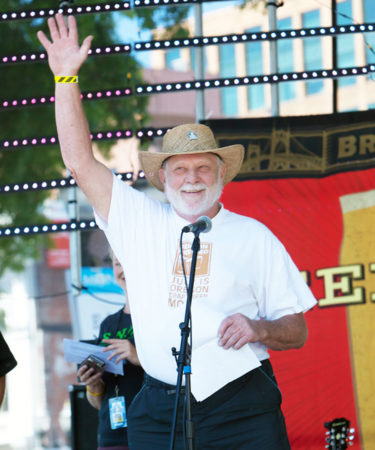Art Larrance, the owner of Cascade Brewing in Portland, Ore., has nothing to be sour about.
“I’ve been fortunate enough that the only sour I have is right here in my glass,” he says, sipping Cascade’s Bourbonic Plague, a blend of sour imperial porters aged in wine and bourbon barrels with dates, cinnamon, vanilla, and orange peel. It won a gold medal at the Great American Beer Festival in 2009, and was recently re-released for the brewery’s 20th anniversary.
“It’s one of our most celebrated beers,” Larrance says. “People have asked us to bring it back since, and what better time than now.”
Larrance co-founded Portland Brewing, one of the city’s four original craft breweries, in 1986. One year prior, he helped lobby state lawmakers to pass legislation enabling breweries to sell beer on site, an act that had been banned since Prohibition. He also helped establish the Oregon Brewers Festival, which is now in its 32nd year and attracts 60,000 guests annually.
Still, his greatest professional accomplishment might be Cascade, which is widely considered a pioneer in American barrel-aged sour beer.
“In the beginning we were definitely a little lost, having a sort of identity crisis,” he says. “We followed the trends of ales and lagers as everyone else did at the time but we really didn’t know who we were.”
Soon Larrance and former brewmaster Ron Gansberg, who had a strong wine background, began building impressive barrel-aging and blending programs in the early aughts. They used a house culture of lactobacillus bacteria, and drew upon the Pacific Northwest’s abundant fruits to produce complex, distinctive sour beers.
“This was a way we could create something truly special and unique to the area,” Larrance tells VinePair. “It was an intense investment and success wasn’t immediate, but the brewers and cellar staff were extremely dedicated, through philosophy and process, to creating some of the best sour beers possible.”
Cascade has since garnered critical and consumer praise for its Northwest Sour Ales, which include Kriek, Sang Noir, and Vlad the Imp Aler. The brewery has expanded several times, first with the Barrel House, in 2010, and then the Blending House, a 23,000-square-foot facility solely dedicated to producing and packaging sour beers, in 2014. The latter currently houses over 2,000 oak barrels, as well as nine foeders ranging from 50 to 65 hectoliters.
What does Larrance do when he’s not overseeing barrel aging or blending? Here, he tackles our Lucky Sevens questions and shares his memories of the industry in the 1980s, favorite Kriek vintage, and how he found out he wasn’t a good day drinker.
1. What’s your desert-island beer?
I’m generally a pale ale drinker, or at least beers on the lighter side of the color spectrum. But I had this black lager once in Prague, called U Fleků. It’s actually available only at the brewery, and it’s the only beer it makes. Each sip melted in my mouth. But who knows how it would taste in a hot climate?
2. What’s the beer that made you fall in love with beer?
My dad was a cabinetmaker. He had his own shop in Portland. I have great memories as a kid of him shutting off the tools at the end of a long day and cracking open a cold can of Olympia. He let me get the last sip and I would say, “Ohhh, that’s so bitter!” This endeared me to beer.
3. FMK three beer types: IPA, pilsner, sour?
I’m not a hophead — I don’t like my tongue to curl up after I take a sip of something — so I would kill IPA. Sour, I would f*ck. You want to sip your sours and take your time with them, and that’s the thing you want to do when you make love. And I would marry pilsner, because pilsner and I have been together for a long time. I can commit to something. I’ve been with the same gal for a long time.
4. You’re on death row. What’s your last-supper beer?
We just celebrated our 20th anniversary and brought back our Bourbanic Plague, a blend of different barrel-aged porters. It seems to be everyone’s favorite of ours so we brought it back. It’s a complex beer, a strong beer, an unusual beer. If I’m on death row, I’d take down a bottle by myself. By the time I reached the end I probably wouldn’t remember the first glass.
5. You can only drink one beer for the rest of your life. What is it?
Portland Ale. This is a pale beer, not overly hopped, made mostly with pilsner malt. It’s supremely refreshing and you can have more than one, which is something I want from a beer. This was our flagship at Portland Brewing. When the trademark lapsed after we closed, I picked it up and we’ve made it ever since. I have fond memories from back in 1986. Craft beer was all about going around to different bars and educating the staff, selling yourself, on this different, new product. Cascade hops in 1986? People thought it was a different language. Now, beer drinkers are educated. I love to see that.
6. What’s the best and worst beer in your fridge right now?
I don’t keep any bad beer in my fridge. I have a lot of our sours, including Kriek from 2011. We’ve done a lot of vertical tastings of Kriek vintages and that year is always my favorite.
7. If you could no longer drink beer, what would be your beverage of choice?
Arnold Palmers. That’s what I like to have at lunch. I worked at a steel foundry out of college and I found early on that I wasn’t a good day drinker. Some of the guys could knock a few back and go back to operating machines and making products. But my head would be spinning.
